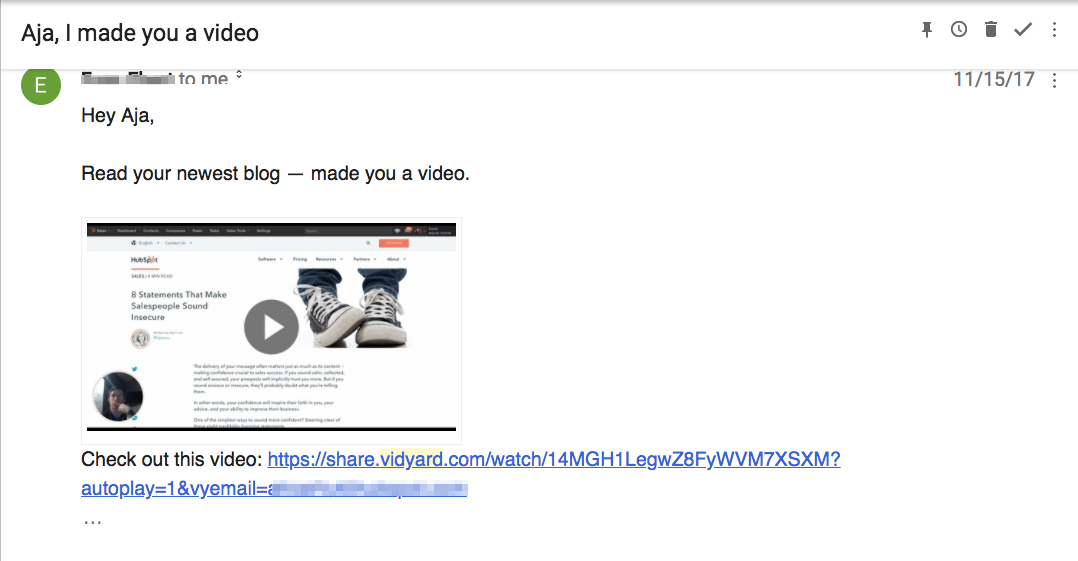According to The New York Times, we’re entering a “post-text world.” Multimedia will soon dominate every channel. In other words, using writing to communicate with your audience is going out of style — and quickly.
As a marketer, you know this means updating or even completely reinventing your digital strategy. But the multimedia world can feel overwhelming. If you want to make a video, where do you start?
First, we recommend identifying your objective. Describe your goal for this video (or series) in a single sentence.
In general, there are three main types of video:
Awareness: Get on your customers’ radar. These videos typically have high-entertainment value and broad appeal, so they attract as many people as possible.
Engagement: Spark a reaction, whether that’s a like, comment, or share. Videos in this category usually play to the viewer’s emotions.
Education: Teach your audience something. If you’re targeting potential customers, that might mean a customer case study. If you’re targeting current customers, it could be a how-to video.
Now that you know your goal and the different types of videos, let’s dive into specific categories.
Awareness
1. Round-ups
Roundup videos are lists curated around a theme, such as “The Top 5 Best Yoga Mats” or “6 Restaurants You Must Try in Atlanta.”
The most effective ones are:
- Relatively short: aim for four minutes or less to keep your audience engaged
- Visual: don’t just speak to the camera; mix in clips or stills of the people, products, or places you’re describing
- Varied: give your viewers a range of options so there’s something for everyone
This roundup from Travelocity featuring the best restaurants in San Francisco is a great example. It’s quick, punchy, and entertaining. And viewers will associate Travelocity with “travel” — meaning next time they’re going on vacation, they’re likelier to use the platform to book a flight, hotel, or package.
2. Company culture/meet the team video
If you want to give customers a sense of your organization’s values, mission, and team members, a video showcasing your culture or introducing a few team members is a solid choice.
These videos help people understand why your company is different and strengthens their brand loyalty.
“Meet MailChimp: Joanna” is one example. In this video, a MailChimp front-end developer explains what she does and how she approaches work.
3. Behind the scenes
Remember this cool and infamous behind-the-scenes photo?

People love being in on the behind the scenes action. If you have exclusive insight into a process, project, or situation your customers would be interested in, consider making a behind-the-scenes (BTS) video. These are usually less polished than traditional videos and incorporate lots of raw footage. As a bonus, they work for both B2C and B2B brands.
For example, RIV Now posted its TYGA “Swap Meet” behind the scenes, showing the creative and production process that went into the hip-hop/rap music video.
Meanwhile, ConvertKit, an email marketing company, uploaded a behind-the-scenes video of its company retreat.
4. Interview
Interview videos usually spotlight one or two people answering (you guessed it) questions. The interviewee should either be someone your audience already knows (an influencer, a well-known speaker, an author, etc.) or someone they don’t know but would enjoy hearing from.
This type of video is fantastic for sharing your company’s values and aligning yourself with an interesting or inspiring person.
Take Anthropologie’s interview with Jacquelyn Jablonski, a model and activist who works with the non-profit Autism Speaks. Her interview is meant to resonate strongly with Anthropologie’s core demographic.
Engagement
5. Humorous video/skit
Next time you’re watching the Super Bowl, keep track of how many funny ads you see. Most Super Bowl commercials are humorous. And for good reason: Getting your viewers to smile or laugh makes them feel good and your brand seem relatable.
Take this parody video by Taulia, an invoice and payment management system. It riffs on Direct TV’s “Get rid of cable” series, turning a potentially boring clip (“here’s why you should use Taulia”) into an amusing and memorable one.
6. Vlog
A vlog, or “video blog,” is diary-style and typically filmed by one person in front of their camera or webcam. A typical vlog describes someone’s personal experience or thoughts on a specific topic.
While influencers tend to use vlogging more than brands, you can definitely still take advantage of this popular genre. To give you an idea, you could ask one of your employees to do a one-day takeover of your YouTube account, showing your audience around the office, taking them along to an industry event, interviewing other team members, and so on.
7. Video emails
Marketers aren’t the only ones using video to hit their numbers — salespeople are, too. I’ve gotten several video emails in the past six months. It’s hard to ignore a message titled “Hey Aja, made a video for you,” especially when the other ones in my inbox are your standard work messages.
An effective sales email video is around one minute long. Introduce yourself, explain why you’re reaching out, and ask for a quick call to “talk about their goals for [insert relevant strategy or department here].”

If you don’t want to create a brand-new video for every prospect, consider making a few you can reuse again and again. Separate them by customer type — for instance, you might film one about blogging advice for content marketers, another about social media for community managers, and another about branded content for advertisers.
Education
8. How-to/explainer
A how-to video/explainer walks your viewers through a process or answers a common question. They’re great for building brand credibility and getting your audience to trust you.
In this video, a Squarespace employee lays out the differences between a domain and web hosting. Squarespace happens to provide both — so anyone who watches this video is probably a good customer.
To make your first how-to/explainer video, come up with a list of questions your buyers usually have. Pick one that’s relatively straightforward and shoot a short video explaining it.
9. Product review
Few consumers buy products these days without consulting their friends, the internet, or both. That’s why a product review video can be so successful: Your audience feels like they’re getting an honest take from someone they like and trust in a highly convenient format.
However, it’s pretty tough to review your own product without seeming biased. With that in mind, try giving influencers a sample, trial, or freebie and asking them to share their thoughts in a video.
To give you an idea, check out this review of meal kit service Blue Apron. Not only does Blue Apron get access to the creator’s audience, it also gets to tap into her credibility.
10. Q&A
There are a couple different variations on the “Question and Answer,” or Q&A, video. You can record someone interviewing another — think someone from your team interviewing an expert. Or you can take questions from your audience and answer them on-camera.
The first is probably best for B2B companies, while the second is ideal for consumer brands.
Bon Appétit’s Q&A series is worth browsing. The publication interviewed famous tastemakers like Chrissy Teigen and Lindsay Vonn, both entertaining and educating its audience.
New York’s famous Museum of Modern Art does a live Q&A series with instructor and artist Corey D’Augustine. D’Augustine, who takes questions from the comments section as well as previous Q&As, demystifies art for the average person. It’s interactive, fresh, and near universally appealing.
11. Announcement video
Have some big news to share with your audience? Whether you’re launching a new product, having an event, opening another store, or starting an initiative, an announcement video helps you get you the message across and build excitement.
I love NPR’s 2018 Tiny Desk Contest video announcement. In under 40 seconds, it introduces the main idea (they’re taking applications from unsigned musicians), lays out the rules, and makes you laugh (one word: hedgehogs).
Your announcement video doesn’t have to be humorous, but it should be attention-grabbing.
12. Case study/testimonial
When it comes to conversion, you can’t beat case studies and testimonials. It’s all thanks to social proof, or the psychological phenomenon that causes people to want something when they see others using it.
Try to find a customer who’s gotten great results or has an incredible story. If you need some inspiration, watch My Life’s Work: How a Hollywood Composer Uses Evernote to Make Music. This well-paced, absorbing video has gotten more than 44,000 views on YouTube.
13. Product tour
Most first-time visitors to your website want to know how your product will improve their lives. But they don’t want to read a bunch of text or scroll through a ton of images — that’s too much work until they know if your product is relevant to their need.
A basic overview of your solution gives them the answer. They can see for themselves what your product looks like and does. If it’s compelling, they’ll usually convert.
Basecamp’s two-minute “how it works” video does a nice job of demoing the product in a friendly, easy-to-watch way.
14. Feature explainer
It can be helpful to zoom in on one aspect or feature of your product. A feature explainer is a great way to do just that: Rather than covering the main features as you would in a product tour, explain how one thing works, its most common use cases, and why it’s so valuable.
To illustrate, watch “Welcome to the Mobile Editor” from Wix. This video shows viewers how the Wix phone app lets them edit their website on the go.
Clips like this can live on your website; plus, you can send them to prospects who are interested in specific features.
15. Live talks/presentations
If a team member is giving a speech, you might as well get double bang for your marketing buck. Film their presentation, talk, or panel, do some minor editing, and voila, you’ve got a (hopefully) great piece of content.
Slack used this strategy at its last conference. “Frontiers by Slack 2017 – Meetings that Don’t Suck” is a recorded version of startup and engineer expert Ken Norton’s session on running effective meetings.
Videos can play a valuable role during every stage of your marketing funnel — from attracting new leads to turning them into paying customers. I hope this guide to the different types of video inspires you.



